|
|
|
Sort Order |
|
|
|
Items / Page
|
|
|
|
|
|
|
| Srl | Item |
| 1 |
ID:
153214
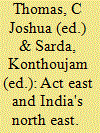

|
|
|
|
|
| Publication |
New Delhi, Pentagon Press, 2017.
|
| Description |
xxii, 146p.hbk
|
| Standard Number |
9788182749436
|
|
|
|
|
|
|
|
|
|
|
|
Copies: C:1/I:0,R:0,Q:0
Circulation
| Accession# | Call# | Current Location | Status | Policy | Location |
| 059110 | 327.541/THO 059110 | Main | On Shelf | General | |
|
|
|
|
| 2 |
ID:
171732
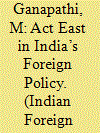

|
|
|
|
|
| Summary/Abstract |
We live today in an interdependent world. The concept of the ‘Global Village’
is a part of India’s culture, and we see ‘Vasudeiva Kutumbhakam’ as a part of
our ethos. A country’s foreign policy contributes immensely towards its
progress and prosperity in a globalising village. This reinforces the idea that
the foreign policy of any country cannot be divorced from its domestic policy
and governance - the influence and outcome of each impact with equal measure
on the other
|
|
|
|
|
|
|
|
|
|
|
|
|
|
|
|
| 3 |
ID:
157037
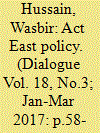

|
|
|
| 4 |
ID:
139172
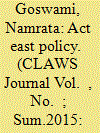

|
|
|
|
|
| Summary/Abstract |
For many years now, since 1992, when it laid its seed and slowly gathered momentum in policy circles, the “Look East” policy has been oft repeated in New Delhi’s strategic and policy circles as one of India’s foremost long-term policy visions to open up its economy for investment and trade with Southeast Asia. Increasingly now, the reference has changed from “Looking East” to “Acting East” by which one would expect that the policy is in its implementation phase. In augmenting the “Act East” policy, the northeast of India emerges, by the criterion of geography, as the region which will act as the ‘strategic catalyst’ or ‘game changer’ in accomplishing the vision that the policy aspires to embolden. Situated between China, Bhutan, Bangladesh, and Myanmar and with an international border stretching up to 4, 500 km, the region has held the promise of acting as a bridge between India and Southeast Asia for years. Its history vindicates such a role as its people have traded and travelled across the Southeast Asian region and Yunnan for years through the ancient Silk Road, trading in Himalayan salt, spices, handicrafts, food items, silk and other goods. This region witnessed migration of people from Southeast Asia and Yunnan to Assam and its surrounding hills, the most prominent being the Ahoms tracing their roots to the Tai race in Yunnan and Thailand. The Ahoms led by Sukapha arrived in Assam in
1228 A.D. and ruled over this region for 600 years. It is significant to note that the Ahoms under Lachit Borphukan successfully prevented Mughal expansion into Assam by defeating the Mughal Army in the much revered Battle of Saraighat of 1671.1
|
|
|
|
|
|
|
|
|
|
|
|
|
|
|
|
| 5 |
ID:
193415
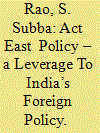

|
|
|
| 6 |
ID:
152900
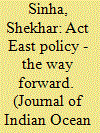

|
|
|
| 7 |
ID:
157040
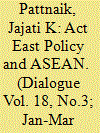

|
|
|
| 8 |
ID:
174191
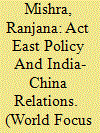

|
|
|
|
|
| Summary/Abstract |
The Act East policy is aimed to put East in centrality in terms of economic activity and political presence to counter the expansionist neighborhood. This in turn will enlarge the domain of the east and strengthen India’s place in global economy which is a win-win situation for India.
|
|
|
|
|
|
|
|
|
|
|
|
|
|
|
|
| 9 |
ID:
175920
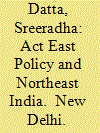

|
|
|
|
|
| Publication |
New Delhi, Vivekananda International Foundation, 2021.
|
| Description |
xxx, 321p.Hbk
|
| Standard Number |
9788194820055
|
|
|
|
|
|
|
|
|
|
|
|
Copies: C:1/I:0,R:0,Q:0
Circulation
| Accession# | Call# | Current Location | Status | Policy | Location |
| 059929 | 337.541059/DAT 059929 | Main | On Shelf | General | |
|
|
|
|
| 10 |
ID:
193347
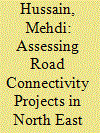

|
|
|
|
|
| Summary/Abstract |
In ten cities of North East India, a total of 523 projects costing ¹ 13563 crores are undergoing development, out of which only 121 projects have seen completion (Singh 2022). The development of roads at the national level should be pushed at a quicker pace. While the SASEC road connectivity projects have focused on connectivity between North East India and its neighbours, the bilateral efforts of upgrading and modernising roads- National Highways, Asian Highways are definitely improving the conditions of connectivity in North East India. Better connectivity is crucial for better income and development for the people of North East India. Coordination with neighbouring countries to remove border restrictions, reduce trust deficit and facilitate for a smooth transport movement is essential for further development of NEI.
|
|
|
|
|
|
|
|
|
|
|
|
|
|
|
|
| 11 |
ID:
164997


|
|
|
|
|
| Publication |
New Delhi, Pentagon Press, 2019.
|
| Description |
xiii, 230p.hbk
|
| Standard Number |
9789386618801
|
|
|
|
|
|
|
|
|
|
|
|
Copies: C:1/I:0,R:0,Q:0
Circulation
| Accession# | Call# | Current Location | Status | Policy | Location |
| 059618 | 327.1/RED 059618 | Main | On Shelf | General | |
|
|
|
|
| 12 |
ID:
188848
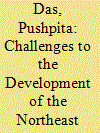

|
|
|
|
|
| Summary/Abstract |
It is argued that the way to bring about development in the Northeast is by economically integrating the region with the vibrant markets of Southeast Asia and East Asia through the Act East Policy. Accordingly, a number of projects have been initiated to improve connectivity between the Northeast and the neighbouring countries. It is believed that connectivity projects will act as growth corridors resulting in economic development of the region. However, to effectively implement the policy and to reap its benefits, it is imperative to overcome challenges such as adverse security situations, bad governance, lack of entrepreneurial skills, absence of markets, and reluctant neighbours.
|
|
|
|
|
|
|
|
|
|
|
|
|
|
|
|
| 13 |
ID:
154562
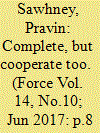

|
|
|
| 14 |
ID:
143993
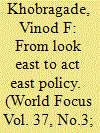

|
|
|
|
|
| Summary/Abstract |
India’s recent foreign policy has been under marking a paradigmatic shift especially by proactive ‘alignment’ with the world powers especially the USA, France, Japan and others. India’s new leadership has learnt the need of new ingredients in its foreign policy with the changing circumstances of the international political equations and more importantly to accomplish its national interests in terms of economy, security and technology that emerged as pre-conditions towards becoming India as one of the leading powers in the world.
|
|
|
|
|
|
|
|
|
|
|
|
|
|
|
|
| 15 |
ID:
143988
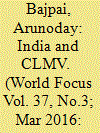

|
|
|
|
|
| Summary/Abstract |
India’s Look East Policy, initiated in 1991 and renamed as ‘Act East’ Policy in 2014, may be cited as a success story of India’s external engagement in the post- Cold War globalized era. The story began in 1992 when Indian Premier made a successful visit of this region and India became a sectoral dialogue partner of ASEAN in the same year. The status of India was elevated to the full dialogue partner in 1995. There was a temporary setback to expanding relations as the US, Japan and other leading counties imposed sanctions against India in reaction to the nuclear tests conducted by her in 1998.
|
|
|
|
|
|
|
|
|
|
|
|
|
|
|
|
| 16 |
ID:
143995
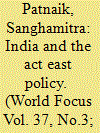

|
|
|
|
|
| Summary/Abstract |
India enjoys a long history of trade and culture exchange with East Asia which started from 1st millennium B.C. when Silk Road and Calicut emerged as major trading port in South Asia. The cultural bond was initiated with the spread of Buddhism during the period of Ashoka the Great.
|
|
|
|
|
|
|
|
|
|
|
|
|
|
|
|
| 17 |
ID:
180080
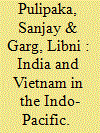

|
|
|
|
|
| Summary/Abstract |
The international order today is characterised by power shift and increasing multipolarity. Countries such as India and Vietnam are working to consolidate the evolving multipolarity in the Indo-Pacific. The article maps the convergences in the Indian and Vietnamese foreign policy strategies and in their approaches to the Indo-Pacific. Both countries confront similar security challenges, such as creeping territorial aggression. Further, India and Vietnam are collaborating with the United States and Japan to maintain a favourable balance of power in the Indo-Pacific. While Delhi and Hanoi agree on the need to reform the United Nations, there is still some distance to travel to find a common position on regional economic architectures. The India–Vietnam partnership demonstrates that nation-states will seek to define the structure of the international order and in this instance by increasing the intensity of multipolarity.
|
|
|
|
|
|
|
|
|
|
|
|
|
|
|
|
| 18 |
ID:
148060
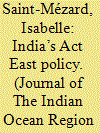

|
|
|
|
|
| Summary/Abstract |
Since the Modi government came to power in June 2014, it has invested diplomatic capital in announcing the transformation of India’s ‘Look East’ policy into a new ‘Act East’ policy. While this new semantics has mostly involved a few nuances and adjustments – rather than a drastic change – in India’s strategic posture, it is nevertheless interesting to analyze the implications of the ‘Act East’ policy for the Indian Ocean Region, and more specifically for its Eastern part – the Bay of Bengal. In this respect, the article shows that India’s ‘Act East’ policy has led to its growing involvement in the Bay of Bengal, especially in the field of maritime affairs. It has also led India to acknowledge its security responsibilities. More generally, India’s recent advances in maritime domain awareness, its interests in enhancing joint patrols and humanitarian assistance and disaster relief (HADR) cooperation, as well as its efforts to contribute to the maritime security of its neighbors, including through weapon transfers, reflect that India is in a nascent positioning as a net security provider, or at least is in an attempt to progress along that line.
|
|
|
|
|
|
|
|
|
|
|
|
|
|
|
|
| 19 |
ID:
170654
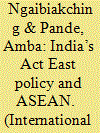

|
|
|
|
|
| Summary/Abstract |
Over the past few decades, India’s security concerns have undergone a substantial change. With the formulation of the Look East Policy (LEP) in the 1990s, the Association of Southeast Asian Nations (ASEAN) as a regional entity became an essential component and a corridor for India’s outreach to Southeast Asia. In 2014, the LEP became more encompassing with a shift to the Act East Policy (AEP). The global security and economic environment too are witnessing significant changes with the USA taking a back seat, China’s aggressive positioning and the Belt and Road Initiative (BRI) coupled with the emerging geopolitical construct of ‘Indo-Pacific’. The regional stakeholders, such as ASEAN, the USA, Japan, Australia and India are yet to form a unified stand on the Indo-Pacific concept as well as the regional security architecture. The AEP appropriately fits into the current scenario as India is set to take up a larger role in the regional security environment while keeping the centrality of ASEAN intact. New Delhi seeks to create a platform for mutual development in the Indo-Pacific and engage with like-minded nations in the quest for a rules-based order that promotes transparency, respect for sovereignty and international law, stability and free and fair-trade framework. India and ASEAN can be apt partners in the Indo-Pacific to play a constructive role and build a regional order.
|
|
|
|
|
|
|
|
|
|
|
|
|
|
|
|
| 20 |
ID:
173800
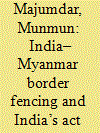

|
|
|
|
|
| Summary/Abstract |
The Manipur–Myanmar border is a fine example in establishing that cross-border linkages are far more central to historical change than previously acknowledged. Fencing of the Manipur–Myanmar border created barriers to economic exchanges and livelihood while dividing cultures and families. Therefore, understanding the ways in which the fencing affects the border communities is important and crucial for comprehending the role of the border communities living along the Manipur–Myanmar border in India’s Act East Policy (AEP), together with in examining the ways in which they can be engaged for the successful implementation of the policy.
|
|
|
|
|
|
|
|
|
|
|
|
|
|
|
|
|
|
|
|
|